- JP
- EN

In our previous interview, we asked him about the concept of his works, how he came to draw pictures, and about Kirigane.
→ http://blog.livedoor.jp/soratobu_penguin/archives/9605694.html Interview ①
This time is a continuation of the interview 1).
-In 2016, you had a solo exhibition at ITOCHU AOYAMA ART SQUARE, right?
Yes, I did.
I was given the opportunity to exhibit my recent works along with the original drawings for the calendar at this venue, as my work was selected for ITOCHU Corporation’s 2016 calendar.
Some of the works were borrowed from the people who own them, so the exhibition was really made possible by the support of many people.
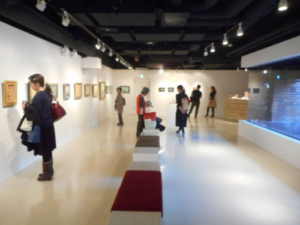
(Venue view )
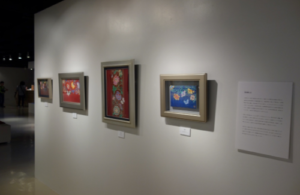
The venue was spacious and open.
We were very grateful that many of the visitors who came once came back with their friends, their own children, or their mothers and fathers, and that they really liked what they saw and heard.
We were also selected as one of the three tours organized by the Minato City Government to visit three museums, where we explained the artworks to the tour group and gave them a tour of the exhibition.
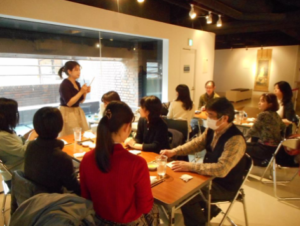
(Scene at the workshop at that time )

(Professor. Nakamura explaining the artworks to the tour group.
The restored reproductions he talked about in Interview 1 were also on display.)
-What is your usual production procedure?
I use the traditional Japanese painting method.
(1) I draw a small sketch and study the composition and color tones with colored pencils.
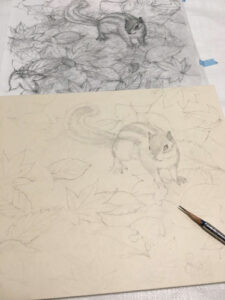
(2) A large sketch is drawn and copied onto Japanese paper using tracing paper.
Before drawing in black ink, supplementary strokes are made with a pencil.
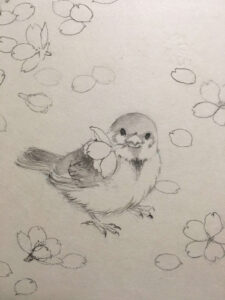
(3) Lines are being drawn in black ink.

(4) Apply a base coat of fine rock paints or water-dry paints, then apply coarse and fine rock paints over the base coat, taking into consideration the properties of each paint.
Because the colors of iwa-enogu (rock paints) become muddy when applied over and over, and colors cannot be mixed if the properties of the paints are different, I do not apply several coats of iwa-enogu.
In the case of my paintings, I use gold leaf, so there is the process of applying the gold leaf after the painting is finished to a certain extent.
The gold leaf is, in other words, a very thin sheet of gold that is beaten and spread out, and then glued to the screen.
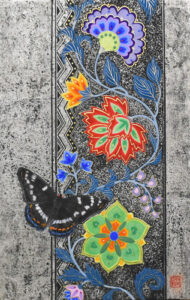
Housoge” p. 4
5) Finally, Kirigane (cut gold) is applied, and a little paint work is done on top so that the Kirigane and gold leaf will blend in with the screen, and the work is completed.
-Housoge” is a series that you have been painting for a long time, isn’t it?
Yes, I have.
Housoge is an imaginary flower that blooms in paradise.
I have been working on this theme for many years in order to elegantly express the longing and attraction of butterflies in this world.
It is unusual among my works to depict imaginary flowers, but I was inspired by the fact that Kirigane is a technique used in Buddhist art.
-What is the work you would like people to see the most among the works in this exhibition?
Each work is a new attempt, different from the previous one, and I try to express it better than the previous one.
The most difficult one is “Nishiki Autumn” (No.15). I dared to draw a black carp on a black background color to contrast with the red and gold of the autumn leaves. I would be happy if you could take a look at it.
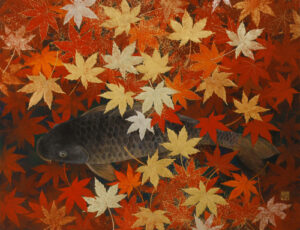
Kinshu” p.15
-What is your most important attitude as an artist?
I think it is important not only to express the world I envision, but also to be able to approach the viewer in order to present it as a work of art.
Also, although it is still a work in progress, I paint in the hope that the emotion I feel when I see a motif can be expressed in color and form, and I would be happy if that is conveyed to the viewer.
-What does painting mean to you?
Painting itself is a way to express what I am moved by the beauty of the shapes and colors of the things that exist in front of me.
-Lastly, please give a message to the viewers of your work.
I would be happy if any of my paintings can be shared by those who share even a single point of view on nature.
Thank you very much.
Thank you, Professor Nakamura, for this valuable talk!
We look forward to seeing your future works.
→Interview①
http://blog.livedoor.jp/soratobu_penguin/archives/9605694.html
You can also view our works on our website.
→https://s-art-web.com/sakka/profile/430.html
For inquiries about our works, please contact us.
→TEL 03-6228-6752mail/info@s-art-web.com